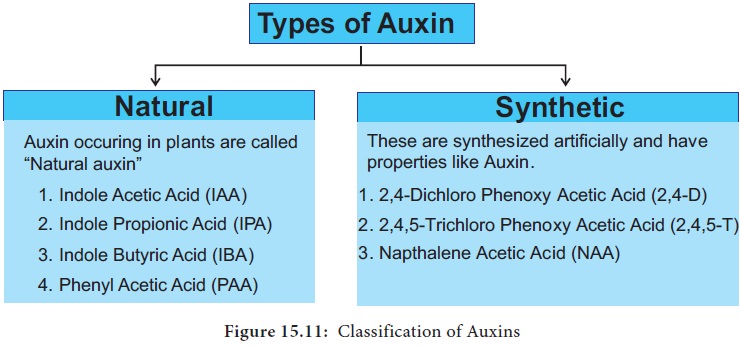Discovery, Occurrence, Types, Physiological Effects, Agricultural role - Auxins - Natural Plant Growth Regulators (PGRs) | 11th Botany : Chapter 15 : Plant Growth and Development
Chapter: 11th Botany : Chapter 15 : Plant Growth and Development
Auxins - Natural Plant Growth Regulators (PGRs)
Auxins
1. Discovery
During
1880, Charles Darwin noted the
unilateral growth and curvature of Canary grass (Phalaris canariensis) coleoptile to light.
The term auxin (Greek: Auxin – to Grow) was first used by F. W. Went in 1926 using Oats (Avena) coleoptile and isolated the auxin. F. W. Went in 1928 collected auxin in agar jelly. Kogl and Haugen Smith (1931) isolated Auxin from human urine, and called it as Auxin A. Later on in 1934, similar active substances was isolated from corn grain oil and was named as Auxin B. Kogl et al., (1934) found heteroauxin in the plant and chemically called it as Indole Acetic Acid (IAA)
2. Occurrence
Auxin is
generally produced by the growing tips of the stem and root, from where they
migrate to the region of the action.
3. Types of Auxin
Auxins
are divided into two categories Natural auxins and Synthetic auxins (Figure
15.11).

Anti-auxins
Anti-auxin compounds when applied to the plant inhibit the
effect of auxin. Example: 2, 4, 5 -Tri Iodine Benzoic Acid (TIBA) and
Napthylpthalamine.
4. Free auxin
They move
out of tissues as they are easily diffusible. Example: IAA.
5. Bound Auxin
They are
not diffusible. Example: IAA-Aspartic acid
6. Precursor
The amino acid Tryptophan is the precursor of IAA and zinc is required for its synthesis.
7. Chemical structure
Auxin has
similar chemical structure of IAA.
8. Transport in Plants
Auxin is
polar in transport. It includes basipetal and acropetal transport. Basipetal
means transport through phloem from shoot to root and acropetal means transport
through xylem from root to shoot.
9. Bioassay (Avena Curvature Test / Went Experiment)
Bioassay
means testing of substances for their activity in causing a growth response in
a living plant or its part.
The procedure involves the following steps:
When the Avena seedlings have attained a height of 15 to 30 mm, about 1mm of the coleoptile tip is removed. This apical part is the source of natural auxin. The tip is now placed on agar blocks for few hours. During this period, the auxin diffuses out of these tips into the agar. The auxin containing agar block is now placed on one side of the decapitated stump of Avena coleoptile.

The auxin from the agar blocks diffuses down through coleoptile
along the side to which the auxin agar block is placed. An agar block without
auxin is placed on another decapitated coleoptile. Within an hour, the
coleoptiles with auxin agar block bends on the opposite side where the agar
block is placed. This curvature can be measured (Figure 15.12).
10. Physiological Effects
·
They promote cell elongation in stem and
coleoptile.
·
At higher concentrations auxins inhibit the
elongation of roots but induce more lateral roots. Promotes growth of root only
at extremely low concentrations.
·
Suppression of growth in lateral bud by apical bud
due to auxin produced by apical bud is termed as apical dominance.
·
Auxin prevents abscission.
·
It is responsible for initiation and promotion of
cell division in cambium, which is responsible for the secondary growth and
tumor. This property of induction of cell division has been exploited for
tissue culture techniques and for the formation of callus.
•
Auxin stimulates respiration.
•
Auxin induces vascular differentiation.
Agent Orange
Mixture of two phenoxy herbicides 2,4-D and 2,4,5-T is given the name ‘Agent orange’ which was used by USA in Vietnam war for defoliation of forest (chemical warfare).

In botanical gardens and tea gardens, gardeners trim the plants regularly so that they remain bushy. Does this practice have any scientific explanation?
Yes, trimming of plants removes apical buds and hence apical
dominance. The lateral buds sprout and make the plants bushy.
11. Agricultural role
o
It is used to eradicate weeds. Example: 2,4-D and
2,4,5-T.
o
Synthetic auxins are used in the formation of
seedless fruits (Parthenocarpic fruit).
o
It is used to break the dormancy in seeds.
o
Induce flowering in Pineapple by NAA & 2,4-D.
o
Increase the number of female flowers and fruits in
cucurbits.

Related Topics